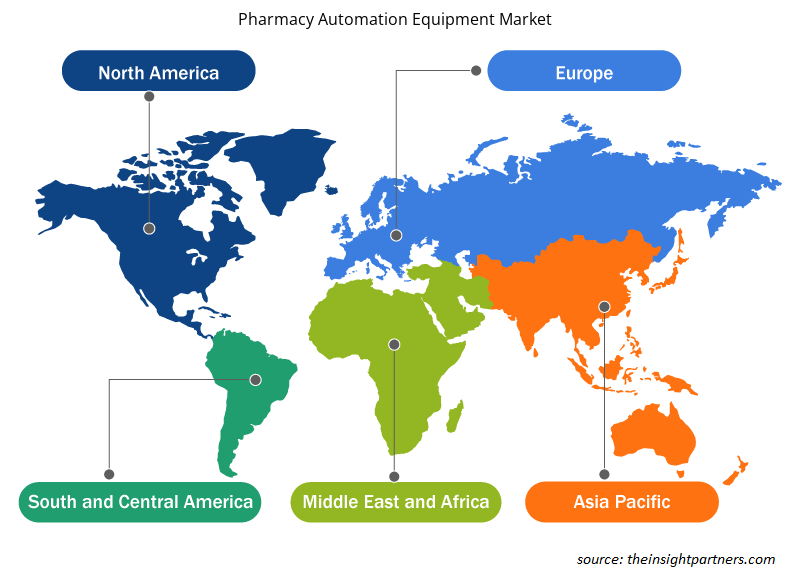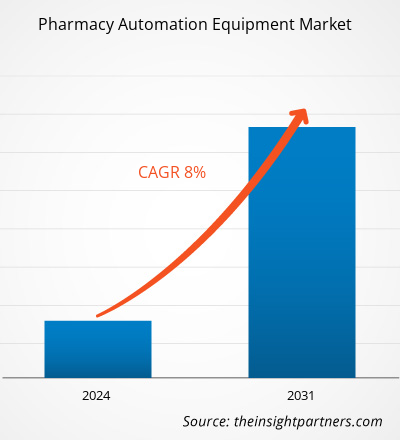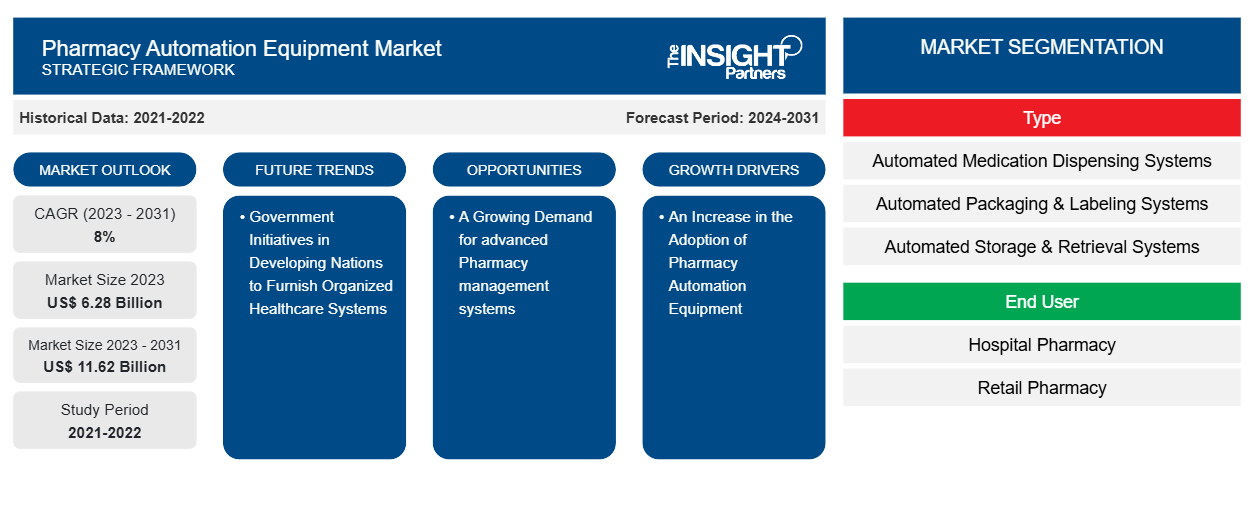Si prevede che la dimensione del mercato delle apparecchiature per l'automazione delle farmacie raggiungerà 11,62 miliardi di dollari entro il 2031, rispetto ai 6,28 miliardi di dollari del 2023. Si prevede che il mercato registrerà un CAGR dell'8,00% nel periodo 2023-2031. L'emergere di sistemi di distribuzione dei farmaci, robotica, intelligenza artificiale (IA), telefarmacie e sistemi di gestione automatizzata dell'inventario rimarranno probabilmente una tendenza chiave nel mercato.
Analisi di mercato delle apparecchiature per l'automazione delle farmacie
Grazie alle nuove tecnologie, il settore sanitario è in continuo cambiamento e miglioramento, soprattutto per le farmacie. Per mantenere puntualità, precisione e accuratezza, le farmacie devono utilizzare una varietà di sistemi, quindi coloro che operano in questo campo devono rimanere aggiornati sui progressi tecnologici. L'automazione delle farmacie è stata all'avanguardia nella rivoluzione tecnologica per il miglioramento dei pazienti e degli operatori sanitari. I farmacisti possono ora gestire le prescrizioni dei pazienti in modo più efficiente e lavorare in modo più produttivo grazie all'automazione, che può gestire qualsiasi cosa, dalle faccende noiose allo scambio fluido di informazioni sanitarie.
Panoramica del mercato delle apparecchiature per l'automazione farmaceutica
Il mercato dei sistemi di automazione per farmacie è guidato dai numerosi vantaggi che offrono alle farmacie. L'automazione migliora la precisione, il flusso di lavoro in farmacia e l'esperienza del paziente, riducendo al contempo le spese e gli errori correlati ai farmaci. Le previsioni future per il mercato globale dell'automazione indicano una crescita esponenziale della domanda di prescrizioni, delle attrezzature tecniche e dell'ampliamento delle conoscenze tecnologiche. Il campo dell'assistenza sanitaria digitale sta rapidamente crescendo e dominando. Il numero di prescrizioni scritte aumenterà di pari passo con l'invecchiamento della popolazione, il che significa che l'automazione avrà un impatto significativo sulla pratica farmaceutica in futuro. L'automazione attualmente combina etichettatura, confezionamento, stoccaggio e distribuzione automatizzati per ridurre gli errori nella distribuzione e aumentare la produttività per i leader delle farmacie. Da questo punto in poi, l'azienda utilizzerà solo l'elettronica e la tecnologia per crescere.
Personalizza questo report in base alle tue esigenze
Riceverai la personalizzazione gratuita di qualsiasi report, comprese parti di questo report, o analisi a livello nazionale, pacchetto dati Excel, oltre a usufruire di grandi offerte e sconti per start-up e università
-
Scopri le principali tendenze di mercato in questo rapporto.Questo campione GRATUITO includerà analisi di dati che spaziano dalle tendenze di mercato alle stime e alle previsioni.
Driver e opportunità del mercato delle apparecchiature per l'automazione farmaceutica
L'aumento dell'adozione di apparecchiature di automazione farmaceutica favorisce la crescita del mercato
L'automazione della farmacia ora avviene con la robotica e l'intelligenza artificiale. I dispositivi meccanici noti come robotica della farmacia possono replicare il comportamento umano una volta che sono programmati per farlo senza l'assistenza costante dell'operatore. Ad esempio, molti sistemi di flusso di lavoro automatizzati, codici a barre della farmacia e sistemi di distribuzione dei farmaci sono tutti classificati come robotici. L'intelligenza artificiale (IA) è un campo in rapido sviluppo nella tecnologia della farmacia che può essere applicato a varie attività come polifarmacologia, progettazione di forme di dosaggio, scoperta di farmaci, programmi per computer e farmacia ospedaliera. Poiché l'IA è in genere utilizzata per imitare le attività cognitive umane, l'industria farmaceutica potrebbe vedere un aumento significativo nell'uso di questa tecnologia. Può essere utilizzata per svolgere attività simili a quelle umane su computer digitali o robot controllati da computer (come armadietti di distribuzione automatizzati). Le principali aziende farmaceutiche stanno iniziando a utilizzare l'intelligenza artificiale (IA) nella ricerca e sviluppo, nella scoperta di farmaci, nell'analisi del sistema sanitario, nell'accuratezza dei farmaci, nel supporto medico e nell'assistenza, aiutando con attività ripetitive, progettazione di piani di trattamento e tenuta delle cartelle cliniche. L'intelligenza artificiale può essere utilizzata nelle farmacie ospedaliere per una varietà di scopi, tra cui la scansione di codici a barre, la preparazione automatizzata dei farmaci, il monitoraggio automatizzato e la distribuzione. Pertanto, un aumento dell'uso abbinato alle applicazioni emergenti dei sistemi di automazione delle farmacie è probabile che stimoli la crescita del mercato.
Iniziative governative nei paesi in via di sviluppo
Poiché i costi sanitari sono in aumento e c'è una pressione crescente per migliorare l'accesso ai servizi, la gestione farmaceutica svolge un ruolo fondamentale nei paesi in via di sviluppo. Ad esempio, il ruolo del farmacista si è ampliato per includere la garanzia di una consulenza appropriata , il monitoraggio e l'aderenza ai farmaci, nonché la prevenzione dello sviluppo della resistenza ai farmaci dell'HIV in molti contesti con risorse limitate gravati dal virus. Ciò genera la necessità di soluzioni tecnologiche all'avanguardia. I governi dei paesi in via di sviluppo stanno implementando diverse misure per rendere questi farmaci più facili da ottenere. Ad esempio, per migliorare la fornitura del trattamento dell'HIV, il Ministero della Salute e dei Servizi Sociali in Namibia ha implementato la distribuzione plurimensile per consentire l'aumento della terapia antiretrovirale. Nelle strutture sanitarie della Namibia, questo è attualmente ampiamente utilizzato, il che aiuta a raggiungere gli obiettivi di trattamento dell'HIV del paese. In India, il settore ospedaliero costituisce l'80% dell'intero mercato sanitario. C'è una domanda significativa da parte di investitori nazionali e internazionali. Di conseguenza, durante il periodo previsto, questi fattori probabilmente genereranno significative opportunità di crescita per il mercato delle apparecchiature di automazione delle farmacie.
Analisi della segmentazione del rapporto di mercato delle apparecchiature per l'automazione delle farmacie
I segmenti chiave che hanno contribuito alla derivazione dell'analisi di mercato delle apparecchiature per l'automazione della farmacia sono la tipologia e l'utente finale.
- In base al tipo, il mercato delle apparecchiature per l'automazione delle farmacie è suddiviso in sistemi di distribuzione automatizzata dei farmaci, sistemi di confezionamento ed etichettatura automatizzati, sistemi di stoccaggio e recupero automatizzati, dispositivi di preparazione automatizzati e contatori di compresse da tavolo. Il segmento dei sistemi di distribuzione automatizzata dei farmaci ha detenuto la quota di mercato più significativa nel 2023.
- In base all'utente finale, il mercato è segmentato in farmacia ospedaliera, farmacia al dettaglio e altri. Il segmento della farmacia ospedaliera ha detenuto la quota maggiore del mercato nel 2023.
Analisi della quota di mercato delle apparecchiature per l'automazione farmaceutica per area geografica
L'ambito geografico del rapporto sul mercato delle apparecchiature per l'automazione delle farmacie è suddiviso principalmente in cinque regioni: Nord America, Asia Pacifico, Europa, Medio Oriente e Africa, e Sud e Centro America.
Il Nord America ha conquistato la quota maggiore del mercato globale, con una crescita guidata da fattori quali la crescente adozione di apparecchiature di automazione farmaceutica negli Stati Uniti, la crescente consapevolezza della salute pubblica, l'aumento delle iniziative governative e la presenza di attori leader. Un fattore chiave della crescita del mercato è l'aumento degli errori di somministrazione dei farmaci e la crescente domanda di prodotti farmaceutici. La crescente popolazione di pazienti negli Stati Uniti indica un aumento del numero di pazienti che assumono più farmaci al giorno. La ricerca mostra che negli Stati Uniti, oltre il 50% dei pazienti ha almeno una prescrizione, con molti che assumono più farmaci al giorno, esponendoli a un rischio maggiore di errori di somministrazione dei farmaci e potenziali rischi per la salute. La crescente domanda di prodotti farmaceutici, l'avanzamento della tecnologia e la necessità di apparecchiature e strumenti robotici precisi per svolgere le attività in modo efficiente dovrebbero essere fattori chiave per la crescita del mercato.U.SU.S. indicates an increase in the number of patients taking multiple medications daily. Research shows that in the U.S., over 50% of patients have at least one prescription, with many taking multiple medications daily, putting them at increased risk of medication errors and potential health risks. The rising demand for pharmaceutical products, advancing technology, and the need for precise robotic equipment and tools to efficiently perform tasks are expected to be key factors for market growth.
Approfondimenti regionali sul mercato delle apparecchiature per l'automazione farmaceutica
Le tendenze regionali e i fattori che influenzano il Pharmacy Automation Equipment Market durante il periodo di previsione sono stati ampiamente spiegati dagli analisti di Insight Partners. Questa sezione discute anche i segmenti e la geografia del Pharmacy Automation Equipment Market in Nord America, Europa, Asia Pacifico, Medio Oriente e Africa e Sud e Centro America.

- Ottieni i dati specifici regionali per il mercato delle apparecchiature per l'automazione delle farmacie
Ambito del rapporto di mercato sulle apparecchiature per l'automazione della farmacia
| Attributo del report | Dettagli |
|---|---|
| Dimensioni del mercato nel 2023 | 6,28 miliardi di dollari USA |
| Dimensioni del mercato entro il 2031 | 11,62 miliardi di dollari USA |
| CAGR globale (2023-2031) | 8% |
| Dati storici | 2021-2022 |
| Periodo di previsione | 2024-2031 |
| Segmenti coperti |
Per tipo
|
| Regioni e Paesi coperti |
America del Nord
|
| Leader di mercato e profili aziendali chiave |
|
Densità degli attori del mercato delle apparecchiature per l'automazione farmaceutica: comprendere il suo impatto sulle dinamiche aziendali
Il mercato delle apparecchiature per l'automazione farmaceutica sta crescendo rapidamente, spinto dalla crescente domanda degli utenti finali dovuta a fattori quali l'evoluzione delle preferenze dei consumatori, i progressi tecnologici e una maggiore consapevolezza dei vantaggi del prodotto. Con l'aumento della domanda, le aziende stanno ampliando le loro offerte, innovando per soddisfare le esigenze dei consumatori e capitalizzando sulle tendenze emergenti, il che alimenta ulteriormente la crescita del mercato.
La densità degli operatori di mercato si riferisce alla distribuzione di aziende o società che operano in un particolare mercato o settore. Indica quanti concorrenti (operatori di mercato) sono presenti in un dato spazio di mercato in relazione alle sue dimensioni o al valore di mercato totale.
Le principali aziende che operano nel mercato delle apparecchiature per l'automazione farmaceutica sono:
- Società Cerner
- AmerisourceBergen
- Baxter International Inc
- Talyst LLC (Swisslog Healthcare)
- Capsa Sanità
- BD
Disclaimer : le aziende elencate sopra non sono classificate secondo un ordine particolare.

- Ottieni una panoramica dei principali attori del mercato delle apparecchiature per l'automazione farmaceutica
Notizie e sviluppi recenti sul mercato delle apparecchiature per l'automazione delle farmacie
Il mercato delle apparecchiature per l'automazione delle farmacie viene valutato raccogliendo dati qualitativi e quantitativi dopo la ricerca primaria e secondaria, che include importanti pubblicazioni aziendali, dati associativi e database. Di seguito sono elencati alcuni degli sviluppi nel mercato delle apparecchiature per l'automazione delle farmacie:
- BD (Becton, Dickinson and Company), azienda leader mondiale nel settore della tecnologia medica, e Frazier Healthcare Partners, importante società di private equity focalizzata esclusivamente sul settore sanitario, hanno annunciato un accordo definitivo per l'acquisizione da parte di BD di Parata Systems, un fornitore innovativo di soluzioni di automazione farmaceutica, per 1,525 miliardi di dollari. (Fonte: BD, comunicato stampa, giugno 2022)
- Le farmacie canadesi che servono i mercati ospedalieri, al dettaglio e dell'assistenza a lungo termine hanno ora accesso alla tecnologia di automazione delle farmacie di nuova generazione per aumentare l'affidabilità, l'efficienza e la sicurezza della gestione dei farmaci. Ciò include sistemi di confezionamento e ispezione delle buste di aderenza e macchine per il riempimento di fiale semi-automatiche a caricamento frontale. (Fonte: News Letter, aprile 2024)
Copertura e risultati del rapporto sul mercato delle apparecchiature per l'automazione farmaceutica
Il rapporto "Dimensioni e previsioni del mercato delle apparecchiature per l'automazione farmaceutica (2021-2031)" fornisce un'analisi dettagliata del mercato che copre le seguenti aree:
- Dimensioni e previsioni del mercato delle apparecchiature per l'automazione farmaceutica a livello globale, regionale e nazionale per tutti i principali segmenti di mercato coperti dall'ambito
- Tendenze del mercato delle apparecchiature per l'automazione delle farmacie e dinamiche di mercato come driver, vincoli e opportunità chiave
- Analisi dettagliata delle cinque forze PEST/Porter e SWOT
- Analisi di mercato delle apparecchiature per l'automazione della farmacia che copre le principali tendenze del mercato, il quadro globale e regionale, i principali attori, le normative e i recenti sviluppi del mercato.
- Analisi del panorama industriale e della concorrenza che copre la concentrazione del mercato, l'analisi della mappa di calore, i principali attori e gli sviluppi recenti nel mercato delle apparecchiature per l'automazione delle farmacie
- Profili aziendali dettagliati
- Analisi storica (2 anni), anno base, previsione (7 anni) con CAGR
- Analisi PEST e SWOT
- Valore/volume delle dimensioni del mercato - Globale, Regionale, Nazionale
- Industria e panorama competitivo
- Set di dati Excel
Report recenti
Rapporti correlati
Testimonianze
Motivo dell'acquisto
- Processo decisionale informato
- Comprensione delle dinamiche di mercato
- Analisi competitiva
- Analisi dei clienti
- Previsioni di mercato
- Mitigazione del rischio
- Pianificazione strategica
- Giustificazione degli investimenti
- Identificazione dei mercati emergenti
- Miglioramento delle strategie di marketing
- Aumento dell'efficienza operativa
- Allineamento alle tendenze normative























 Ottieni un campione gratuito per - Mercato delle apparecchiature per l'automazione farmaceutica
Ottieni un campione gratuito per - Mercato delle apparecchiature per l'automazione farmaceutica